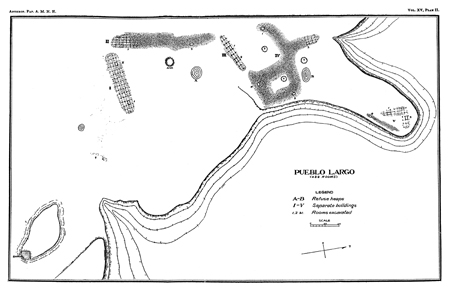
Pueblo Largo
Galisteo Basin Sites
- Lamy Jct
- Lower Arroyo Hondo Pueblo
- El Camino Real
- Chamisa Locita
- El Crestón
- Espinoso Ridge Pueblo
- La Cienega Pueblo (LA 3)
- La Cienega Pithouse Village
- La Cieneguilla Pueblo (LA 16)
- La Cieneguilla Petroglyphs
- Manzanares Pueblo
- Paa-ko
- Petroglyph Hill
- Pueblo Blanco
- Pueblo Colorado
- Pueblo Galisteo
- Pueblo Largo
- Pueblo San Cristóbal
- Pueblo San Lazaro
- Pueblo Shé
- Rote Chert Quarry
- San José de Las Huertas
- Upper Arroyo Hondo Pueblo
- Pueblo San Marcos
The pueblo is in an impressive location on top of a steep-sided ridge.
To the east and the south the land drops precipitously to the open grasslands surrounding Arroyo Estacada. Approach from the west is easier, especially to Nelson’s Roomblocks I
and II. It is still a considerable climb to reach Roomblocks III and IV, and Roomblock V, the earliest part of the village, dating to the 1290s, sits on a  promontory that drops away on three sides. There are at least four clearly defined plazas of varying sizes, several of which would have been dramatic public spaces. Roomblock V probably contained a small plaza enclosed by the triangular roomblock. There are perhaps four kivas in the plazas and two kivas within Roomblock V, four of which were excavated or partly excavated by Bertha Dutton. There is a world shrine on a promontory southeast of the village. Due to the height of the landform and the openness of the countryside, it is possible to
see for great distances. The Sangre de Cristo Mountains reign over this vista.
promontory that drops away on three sides. There are at least four clearly defined plazas of varying sizes, several of which would have been dramatic public spaces. Roomblock V probably contained a small plaza enclosed by the triangular roomblock. There are perhaps four kivas in the plazas and two kivas within Roomblock V, four of which were excavated or partly excavated by Bertha Dutton. There is a world shrine on a promontory southeast of the village. Due to the height of the landform and the openness of the countryside, it is possible to
see for great distances. The Sangre de Cristo Mountains reign over this vista.
Pueblo Largo has seen more excavation than many of the Galisteo sites. Nels Nelson includes it in his 1914 report, and Bertha Dutton excavated with her Girl Scout program at Largo from
1951 to 1956. Dutton’s materials, which are mostly at the Laboratory of Anthropology, consist of 61 whole cartons, 57 one-half cartons, 91 one-quarter cartons, 25 one-eighth cartons, and 12 nonstandard containers. Nelson refers to Pueblo Largo as “the smallest of the Galisteo pueblos.” He dug 13 rooms in five  roomblocks, estimating a total of 489 rooms at the pueblo. His materials are at the American Museum of Natural History in New York. The notes and pottery of the Dutton work are being organized and analyzed by Gordon Wilson and others at the Laboratory of Anthropology. They have experienced considerable difficulty finding excavation notes and correlating notes with proveniences. A total of 371 tree-ring samples were taken from Pueblo Largo, of which 88 have some part of
the outer ring. Tree rings and pottery place Pueblo Largo in the mid to late 1200s to mid 1400s. Black-on-white and Glaze I ceramics dominate, with a smaller portion of Glaze II and III and small amounts of trade ceramics from west-central New Mexico and east-central Arizona. Snead discusses Pueblo Largo in the context of his study of conflict in the Galisteo Basin.
roomblocks, estimating a total of 489 rooms at the pueblo. His materials are at the American Museum of Natural History in New York. The notes and pottery of the Dutton work are being organized and analyzed by Gordon Wilson and others at the Laboratory of Anthropology. They have experienced considerable difficulty finding excavation notes and correlating notes with proveniences. A total of 371 tree-ring samples were taken from Pueblo Largo, of which 88 have some part of
the outer ring. Tree rings and pottery place Pueblo Largo in the mid to late 1200s to mid 1400s. Black-on-white and Glaze I ceramics dominate, with a smaller portion of Glaze II and III and small amounts of trade ceramics from west-central New Mexico and east-central Arizona. Snead discusses Pueblo Largo in the context of his study of conflict in the Galisteo Basin.
As part of the San Cristóbal Ranch, Pueblo Largo is entirely privately owned. It is listed as Number 110 on the State Register of Historic Places.

© New Mexico Office of Archaeological Studies, a division of the New Mexico Department of Cultural Affairs.
The Center for New Mexico Archaeology
7 Old Cochiti Road
Santa Fe, NM 87507
505-476-4404
Fax: 505-476-4448

